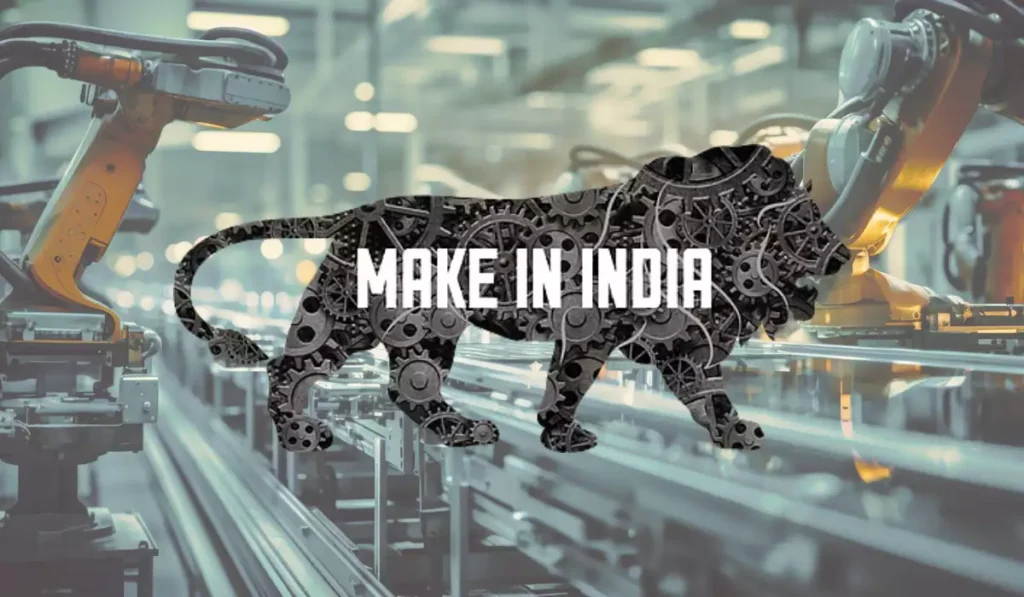The ‘Make in India’ initiative, launched in 2014, has recently completed 10 years in 2024.
Key Highlights of the Decade (2014-2024)
Foreign Direct Investment (FDI)
- India attracted USD 667.4 billion in cumulative FDI (2014-24), a 119% increase compared to the previous decade (2004-14).
- Manufacturing sector received USD 165.1 billion in FDI, a 69% increase over the previous decade.
Production Linked Incentive (PLI) Scheme
- ₹1.32 lakh crore (USD 16 billion) investments generated through PLI schemes.
- Manufacturing output increased by ₹10.90 lakh crore (USD 130 billion) by June 2024.
- Over 8.5 lakh jobs created both directly and indirectly.
Exports and Employment
- Merchandise exports crossed USD 437 billion in FY 2023-24.
- PLI schemes contributed an additional ₹4 lakh crore in exports.
- Employment in the manufacturing sector rose from 57 million (2017-18) to 64.4 million (2022-23).
Ease of Doing Business
- India improved its World Bank Ease of Doing Business ranking from 142nd (2014) to 63rd (2019).
- Over 42,000 compliances reduced and 3,700 provisions decriminalized.
- Jan Vishwas (Amendment of Provisions) Act, 2023 decriminalized 183 provisions across 42 Central Acts.
Key Reforms and Initiatives
Semiconductor Ecosystem Development
- Semicon India Program worth ₹76,000 crore aims to develop semiconductor and display manufacturing with capital support and technological collaborations.
National Single Window System (NSWS)
- Launched in September 2021, this platform integrates clearances from 32 Ministries/Departments and 29 States/UTs to provide faster approvals.
PM Gati Shakti National Master Plan (NMP)
- A GIS-based platform launched in October 2021 for integrated multimodal infrastructure planning to reduce logistics costs and enhance efficiency.
National Logistics Policy (NLP)
- Introduced in 2022 to reduce logistics costs, increase efficiency, and make Indian products more globally competitive.
Industrial Corridors and Infrastructure Development
- 11 industrial corridors under the National Industrial Corridor Development Programme, with 12 new projects approved, involving an investment of ₹28,602 crore.
One-District-One-Product (ODOP)
- Promotes local craftsmanship by fostering indigenous products. Unity Malls established in 27 states to showcase local products.
Startup India Initiative
- Launched in 2016, the initiative resulted in 1,40,803 recognized startups by June 2024, creating over 15.5 lakh jobs.
Government Efforts to Boost Investment and Manufacturing
- Comprehensive reforms including Goods and Services Tax (GST), reduction in corporate tax, and ease of doing business initiatives have been implemented to foster both domestic and foreign investments.
- Programs like the Phased Manufacturing Programme (PMP), public procurement orders, and Quality Control Orders (QCOs) aim to promote domestic manufacturing.
- Tools like India Industrial Land Bank (IILB), Industrial Park Rating System (IPRS), and Project Development Cells (PDCs) streamline processes for investors.
- Initiatives such as Atmanirbhar Bharat, National Infrastructure Pipeline (NIP), and National Monetization Pipeline (NMP) turned post-COVID-19 adversity into an opportunity for economic growth.
Sector-wise Success
- Transportation: Development of projects like the Vande Bharat Express.
- Defence Manufacturing: Milestones like the launch of INS Vikrant, India’s first indigenously-built aircraft carrier.
- Electronics: Establishment of Samsung’s World’s Largest Mobile Factory in Noida.
About Make in India
- Make in India is aimed at transforming India into a global manufacturing hub and a leading investment destination.
- Launched in: 2014
- Led by the Department for Promotion of Industry and Internal Trade (DPIIT), Ministry of Commerce and Industry, Government of India.
Objectives:
- Attract foreign investment and develop India’s industrial base to compete with global players.
- Increase manufacturing sector growth to 12-14% per annum over the medium term.
- Expand the share of manufacturing in India’s GDP from 16% to 25% by 2022.
- Generate 100 million additional jobs by 2022.
- Promote export-led growth.
Key Pillars of Make in India:
- New Processes: Emphasis on improving ease of doing business.
- New Infrastructure: Building state-of-the-art infrastructure for manufacturing.
- New Sectors: Focus on 27 sectors including manufacturing, infrastructure, and services under Make in India 2.0.
- New Mindset: The government acts as a facilitator rather than a regulator.
Make in India 2.0
- Make in India 2.0 focuses on sustainability, innovation, and self-reliance.
- Strategic interventions in renewable energy, green technologies, and advanced manufacturing aim to ensure that Indian products meet global standards.
Ref: Source
| UPSC IAS Preparation Resources | |
| Current Affairs Analysis | Topperspedia |
| GS Shots | Simply Explained |
| Daily Flash Cards | Daily Quiz |
Frequently Asked Question:
What is the Make in India initiative?
Make in India is a government initiative launched in 2014 aimed at transforming India into a global manufacturing hub and leading investment destination.
How much FDI has India attracted under Make in India?
India attracted $667.4 billion in cumulative Foreign Direct Investment (FDI) between 2014 and 2024, marking a 119% increase from the previous decade.
What impact has the Production Linked Incentive (PLI) Scheme had?
The PLI Scheme generated ₹1.32 lakh crore in investments and increased manufacturing output by ₹10.90 lakh crore by June 2024.
How has Make in India impacted employment in the manufacturing sector?
Employment in the manufacturing sector rose from 57 million in 2017-18 to 64.4 million in 2022-23, with over 8.5 lakh jobs created through PLI schemes.
What is Make in India 2.0 focused on?
Make in India 2.0 focuses on sustainability, innovation, and self-reliance, with strategic interventions in renewable energy, green technologies, and advanced manufacturing.



